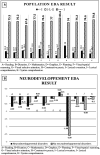Neurodevelopment at seven years and parents' feelings of prematurely born children
- PMID: 36545662
- PMCID: PMC9760962
- DOI: 10.3389/fped.2022.1004785
Neurodevelopment at seven years and parents' feelings of prematurely born children
Abstract
Background: The evolution of knowledge and technical advances in neonatal resuscitation have improved the survival of very premature babies. However, the long-term neurodevelopmental prognosis and cognitive and learning abilities are still uncertain.
Objective: This study aimed to evaluate the neurodevelopment and learning abilities of 7-year-old children born prematurely, and their parents' feelings at 8 years of age.
Patients and methods: Data from children born before 33 weeks gestation in a level III maternity hospital and involved in a regional follow-up network were analyzed at 7 years of age. Neurodevelopmental abnormalities were defined as cerebral palsy, hearing or visual impairment, and/or behavioral abnormalities. School performance was evaluated by the EDA test. A parents' questionnaire assessed their feelings about the child's and family's quality of life at 8 years of age.
Results: At 7 years of age, 51% of the 238 children presented neurodevelopmental abnormalities: 3.3% with cerebral palsy, 6.2% with hearing impairments, 50.7% with visual impairments, and 11.3% with behavioral disorders. The children with neurodevelopmental abnormalities had lower gestational age (29.0 ± 2.0 vs. 30.0 ± 2.1 weeks, p = 0.003) and more EEG abnormalities during the neonatal period (31.1% vs. 19.8%, p = 0.048) than the children without abnormalities. Ninety-four percent of the children with abnormalities were enrolled in normal schools, 33% with special support. In the overall cohort, 31% of the children had all academic performance scores in the normal range of the reference population. At 8 years old, 39% of the parents of children with neurodevelopmental abnormalities felt that their child's situation significantly impacted their quality of life compared to 14% of parents of children without neurodevelopmental abnormality (p = 0.022).
Conclusion: Half of children born very prematurely present with long-term neurodevelopmental abnormalities, which their parents feel significantly impacts their quality of life.
Keywords: extreme prematurity; neurodevelopmental abnormalities; parental feelings; perinatal network; quality of life.
© 2022 Mercier, Deforge and Hascoët.
Conflict of interest statement
The authors declare that the research was conducted in the absence of any commercial or financial relationships that could be construed as a potential conflict of interest.
Figures



References
-
- Larroque B, Ancel P-Y, Marret S, Marchand L, André M, Arnaud C, et al. Neurodevelopmental disabilities and special care of 5-year-old children born before 33 weeks of gestation (the EPIPAGE study): a longitudinal cohort study. Lancet. (2008) 371(9615):813–20. 10.1016/S0140-6736(08)60380-3 - DOI - PubMed
LinkOut - more resources
Full Text Sources

